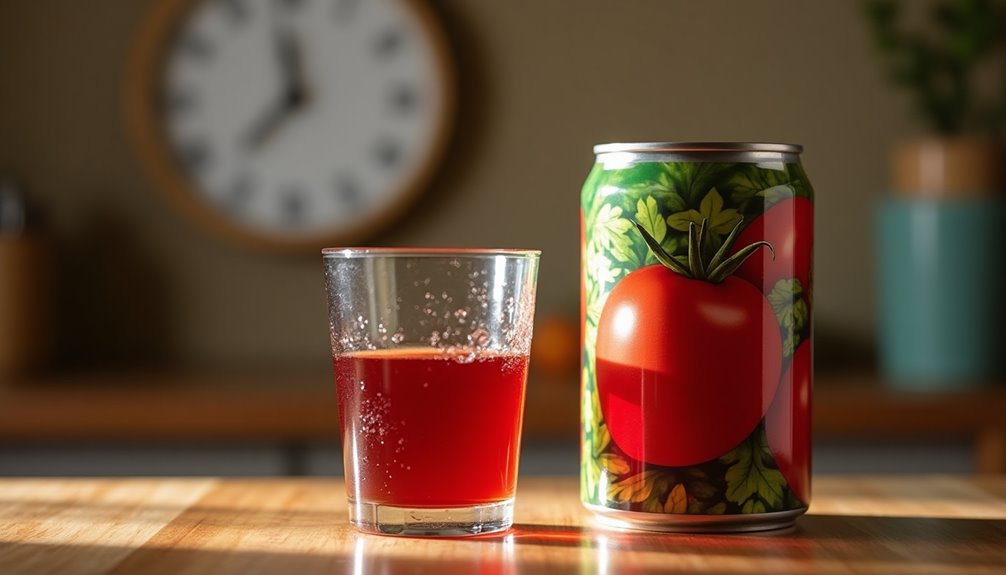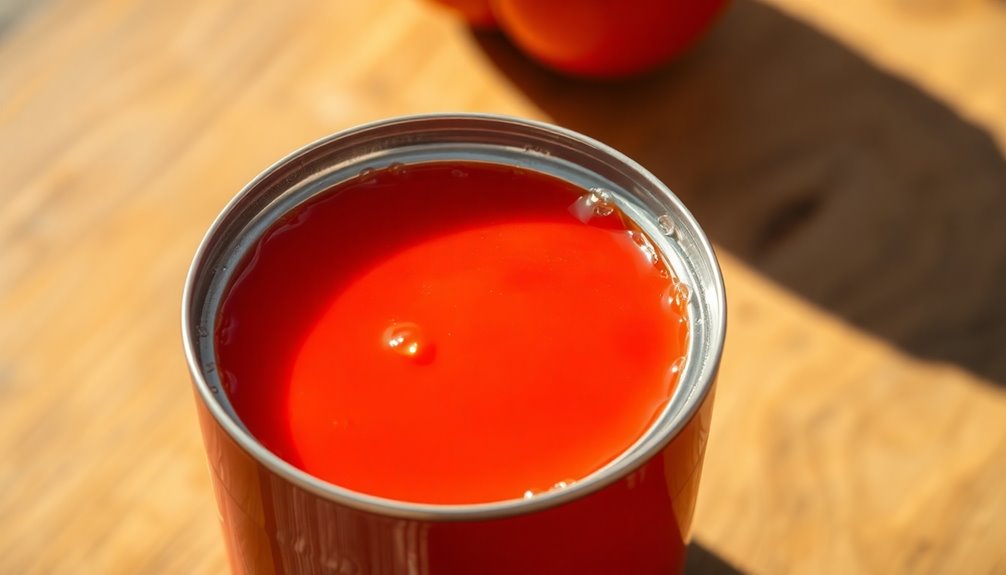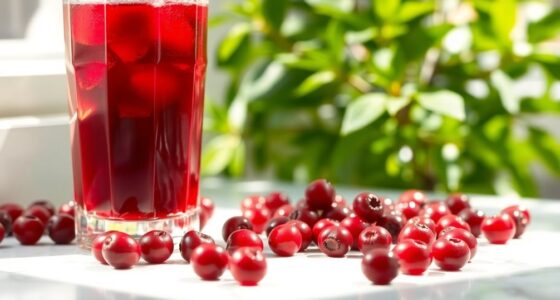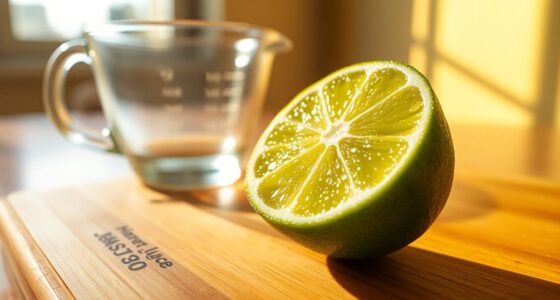Canned tomato juice lasts about 18 to 24 months when unopened, especially if you keep it in a cool, dark place. After opening, it's best to refrigerate it and use it within 7 to 10 days for optimal quality. If the can is undamaged, don't worry too much about expiration dates; just trust your senses. There's more you should know about storage and spoilage, so keep going to find out!
Key Takeaways
- Unopened canned tomato juice lasts 18 to 24 months when stored in a cool, dark place.
- Opened tomato juice should be refrigerated and consumed within 7 to 10 days for best quality.
- Canned tomato juice can be frozen for 8 to 12 months without significant loss of quality.
- Undamaged cans can be consumed past the expiration date, while damaged cans should be discarded immediately.
- Regularly check for off odors, changes in flavor, or mold to determine spoilage.

Have you ever wondered how long you can keep canned tomato juice before it goes bad? It's a common question, especially for those who love to stock their pantry with this versatile ingredient.
Canned tomato juice, when unopened and properly stored in a cool, dark place, can maintain its best quality for a solid 18 to 24 months. That’s right! If you’ve got a can that’s past its expiration date, don’t panic just yet. As long as the can is undamaged, it remains safe to consume even beyond that timeframe. Once you’ve opened a can of tomato juice, it’s best to transfer any leftovers to an airtight container and refrigerate. This can help ensure the juice retains its freshness for 5 to 7 days. Similarly, if you’re also curious about how to store cranberry juice, keep it in the refrigerator after opening, and always check for off smells or flavors before use. By following these simple storage tips, you can enjoy your juices for longer while minimizing waste.
Once you've opened a can of tomato juice, the rules change a bit. To keep that delicious flavor and ensure food safety, you should refrigerate the juice and aim to consume it within 7 to 10 days. This is crucial for maintaining the best quality and enjoying the fresh taste you expect from your canned tomato juice.
If you find yourself with leftovers, don't fret—there's always the option to freeze it. Canned tomato juice can be safely stored in the freezer for 8 to 12 months while still keeping its quality intact. Just remember, as long as it's kept at 0°F, it's safe to consume indefinitely!
However, it's essential to keep an eye out for signs of spoilage. If you notice any off odors, changes in flavor or appearance, or even mold, it's time to discard the product. Trust your senses; they usually know best when something has gone wrong.
Additionally, if your canned tomato juice is in a damaged container—like one that's leaking or bulging—don't take any chances. Dispose of it immediately, regardless of the expiration date, to ensure your safety.
When you're storing canned tomato juice, always keep it in a place that's cool and dark. This simple guideline can help you maintain the best quality for longer.
If you're like many who enjoy cooking with tomato juice, knowing how to store it properly can save you both time and money. You won't have to worry about waste or spoilage if you follow these straightforward tips.
Frequently Asked Questions
How Long Will Home Canned Tomato Juice Last?
When you're thinking about home canned tomato juice, you'll want to enjoy it within a year for the best quality.
After that, it's still safe to use if the jars are sealed properly, but you might notice changes in flavor, color, or texture.
To extend its shelf life, store it in a cool, dark place and always check for any signs of spoilage before using.
Prioritizing its use within a year ensures better taste.
Does Tomato Juice Go Bad?
You might wonder if that can of tomato juice in your pantry has turned sour. Spoilage can sneak up on you, especially if you're not paying attention.
If you notice off odors, changes in flavor, or even mold, it's time to let it go. Always check for damaged cans—bulging or rusting signals trouble.
Trust your senses; when in doubt, toss it out to avoid any unpleasant surprises in your meal.
Can You Eat Canned Tomatoes 2 Years Out of Date?
You can eat canned tomatoes two years past their expiration date if the can's in good shape and you've stored it properly.
Just make sure to inspect it for any signs of spoilage like rust, bulging, or leaks.
When you open the can, check for off odors or unusual colors.
While the quality might decline, it's often still safe to consume as long as it looks and smells okay.
How Long Is Campbell's Tomato Juice Good For?
You might find yourself enjoying a cold glass of Campbell's Tomato Juice, but how long is it actually good for?
When unopened, it lasts 18-24 months if stored properly. Once you crack it open, though, you should consume it within 7 to 10 days for the best taste.
Always check the can for any damage before enjoying—better safe than sorry!
If you freeze it, it stays good for about 8-12 months.
Conclusion
In the grand pantry of life, canned tomato juice can be a trusty companion, lasting up to a year when unopened and a week once you've cracked it open. Just keep an eye out for any signs of spoilage; a little mold or off smell can turn that vibrant red elixir into a forgotten memory. So, when in doubt, toss it out! With proper care, your tomato juice can add a splash of flavor to your meals for many moons to come.
Cindy thoroughly researches juicing trends, techniques, and recipes to provide readers with practical advice and inspiration. Her writing style is accessible, engaging, and designed to make complex concepts easy to understand. Cindy’s dedication to promoting the advantages of juicing shines through her work, empowering readers to make positive changes in their lives through the simple act of juicing.











